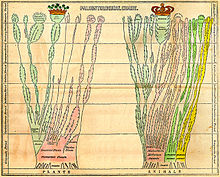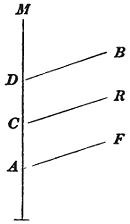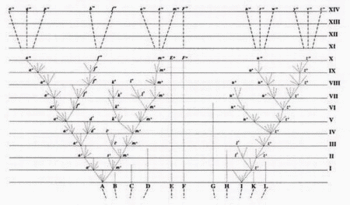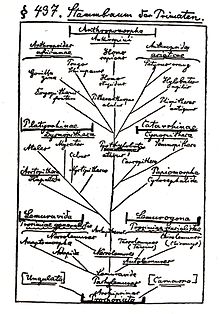- Tree of life (biology)
-
- See also Tree of life (disambiguation) for other meanings of the Tree of Life.
Charles Darwin proposed that phylogeny, the evolutionary relatedness among species through time, was expressible as a metaphor he termed the Tree of Life. The modern development of this idea is called the Phylogenetic tree.
Contents
Early Trees of Life
Although the mutability of species may have appeared in paintings[1] and trees have been used as a metaphor for other purposes (Porphyrian tree) earlier than 1800, the combination of the concept of branching evolution and the tree image did not appear before 1800. The earliest tree of life was published by the French botanist Augustin Augier in 1801. It shows the relationships between members of the plant kingdom.
Jean-Baptiste Lamarck (1744–1829) produced the first branching tree of animals in his Philosophie Zoologique (1809). It was an upside-down tree starting with worms and ending with mammals. However, Lamarck did not believe in common descent of all life. Instead, he believed that life consists of separate parallel lines advancing from simple to complex.[2]
The American geologist Edward Hitchcock (1763–1864) published in 1840 the first Tree of Life based on paleontology in his Elementary Geology.[3] On the vertical axis are paleontological periods. Hitchcock made a separate tree for plants (left) and animals (right). The plant and the animal tree are not connected at the bottom of the chart. Furthermore, each tree starts with multiple origins. Hitchcock's tree was more realistic than Darwin's 1859 theoretical tree (see below) because Hitchcock used real names in his trees. It is also true that Hitchcock's trees were branching trees. However, they were not real evolutionary trees, because Hitchcock believed that a deity was the agent of change. That was an important difference with Darwin.
The first edition of Vestiges of the Natural History of Creation, which was published anonymously in 1844 in England, contained a tree like diagram (p. 212) in the chapter 'Hypothesis of the development of the vegetable and animal kingdoms'. It shows a model of embryological development where fish (F), reptiles (R), and birds (B) represent branches from a path leading to mammals (M). In the text this branching tree idea is tentatively applied to the history of life on earth: "there may be branching" (p. 191), but the branching diagram is not displayed again specifically for this purpose.[4] However, the image of a branching tree could easily have inspired others to use it explicitly as a representation of the history of life on earth.
In 1858, a year before Darwin's Origin, the paleontologist Heinrich Georg Bronn (1800–1862) published a hypothetical tree labeled with letters. Although not a creationist, Bronn did not propose a mechanism of change.[5]
Darwin's Tree of Life
Charles Darwin (1809–1882) was the first to produce an evolutionary tree of life. He was very cautious about the possibility of reconstructing the history of life. In On the Origin of Species (1859) Chapter IV he presented an abstract diagram of a theoretical Tree of Life for species of an unnamed large genus (see figure). On the horizontal base line hypothetical species within this genus are labelled A – L and are spaced irregularly to indicate how distinct they are from each other, and are above broken lines at various angles suggesting that they have diverged from one or more common ancestors. On the vertical axis divisions labelled I – XIV each represent a thousand generations. From A, diverging lines show branching descent producing new varieties, some of which go extinct, so that after ten thousand generations descendants of A have become distinct new varieties or even sub-species a10, f10, and m10. Similarly, the descendants of I have diversified to become the new varieties w10 and z10. The process is extrapolated for a further four thousand generations so that the descendants of A and I become fourteen new species labelled a14 to z14. While F has continued for fourteen thousand generations relatively unchanged, species B,C,D,E,G,H,K and L have gone extinct. In Darwin's own words: "Thus the small differences distinguishing varieties of the same species, will steadily tend to increase till they come to equal the greater differences between species of the same genus, or even of distinct genera.".[6] This is a branching pattern with no names given to species, unlike the more linear tree Ernst Haeckel made years later (figure below) which includes the names of species and shows a more linear development from "lower" to "higher" species. In his summary to the section as revised in the 6th edition of 1872, Darwin explains his views on the Tree of Life:
 Page from Darwin's notebooks around July 1837 showing his first sketch of an evolutionary tree.
Page from Darwin's notebooks around July 1837 showing his first sketch of an evolutionary tree. The affinities of all the beings of the same class have sometimes been represented by a great tree. I believe this simile largely speaks the truth. The green and budding twigs may represent existing species; and those produced during former years may represent the long succession of extinct species. At each period of growth all the growing twigs have tried to branch out on all sides, and to overtop and kill the surrounding twigs and branches, in the same manner as species and groups of species have at all times overmastered other species in the great battle for life. The limbs divided into great branches, and these into lesser and lesser branches, were themselves once, when the tree was young, budding twigs; and this connection of the former and present buds by ramifying branches may well represent the classification of all extinct and living species in groups subordinate to groups. Of the many twigs which flourished when the tree was a mere bush, only two or three, now grown into great branches, yet survive and bear the other branches; so with the species which lived during long-past geological periods, very few have left living and modified descendants. From the first growth of the tree, many a limb and branch has decayed and dropped off; and these fallen branches of various sizes may represent those whole orders, families, and genera which have now no living representatives, and which are known to us only in a fossil state. As we here and there see a thin straggling branch springing from a fork low down in a tree, and which by some chance has been favoured and is still alive on its summit, so we occasionally see an animal like the Ornithorhynchus or Lepidosiren, which in some small degree connects by its affinities two large branches of life, and which has apparently been saved from fatal competition by having inhabited a protected station. As buds give rise by growth to fresh buds, and these, if vigorous, branch out and overtop on all sides many a feebler branch, so by generation I believe it has been with the great Tree of Life, which fills with its dead and broken branches the crust of the earth, and covers the surface with its ever-branching and beautiful ramifications.
The affinities of all the beings of the same class have sometimes been represented by a great tree. I believe this simile largely speaks the truth. The green and budding twigs may represent existing species; and those produced during former years may represent the long succession of extinct species. At each period of growth all the growing twigs have tried to branch out on all sides, and to overtop and kill the surrounding twigs and branches, in the same manner as species and groups of species have at all times overmastered other species in the great battle for life. The limbs divided into great branches, and these into lesser and lesser branches, were themselves once, when the tree was young, budding twigs; and this connection of the former and present buds by ramifying branches may well represent the classification of all extinct and living species in groups subordinate to groups. Of the many twigs which flourished when the tree was a mere bush, only two or three, now grown into great branches, yet survive and bear the other branches; so with the species which lived during long-past geological periods, very few have left living and modified descendants. From the first growth of the tree, many a limb and branch has decayed and dropped off; and these fallen branches of various sizes may represent those whole orders, families, and genera which have now no living representatives, and which are known to us only in a fossil state. As we here and there see a thin straggling branch springing from a fork low down in a tree, and which by some chance has been favoured and is still alive on its summit, so we occasionally see an animal like the Ornithorhynchus or Lepidosiren, which in some small degree connects by its affinities two large branches of life, and which has apparently been saved from fatal competition by having inhabited a protected station. As buds give rise by growth to fresh buds, and these, if vigorous, branch out and overtop on all sides many a feebler branch, so by generation I believe it has been with the great Tree of Life, which fills with its dead and broken branches the crust of the earth, and covers the surface with its ever-branching and beautiful ramifications.Haeckel's Tree of Life
Ernst Haeckel (1834–1919) constructed several Trees of Life. Left is shown the first sketch of the famous Haeckel's Tree of Life in the 1860s which shows "Pithecanthropus alalus" as the ancestor of Homo sapiens. In the middle is the Tree of Life from Generelle Morphologie der Organismen (1866) with three kingdoms Plantae, Protista and Animalia. On the right is the 'Pedigree of Man' published in The Evolution of Man (1879).
The tree of life today
The model of a tree is still considered valid for eukaryotic life forms. As of 2010[update], research into the earliest branches of the eukaryote tree has suggested a tree with either four supergroups[8][9] or two supergroups.[10] There does not yet appear to be a consensus; in a review article, Roger and Simpson conclude that "with the current pace of change in our understanding of the eukaryote tree of life, we should proceed with caution."[11]
Biologists now recognize that the prokaryotes, the bacteria and archaea have the ability to transfer genetic information between unrelated organisms through horizontal gene transfer (HGT). Recombination, gene loss, duplication, and gene creation are a few of the processes by which genes can be transferred within and between bacterial and archaeal species, causing variation that is not due to vertical transfer.[12][13][14] There is emerging evidence of HGT occurring within the prokaryotes at the single and multicell level and the view is now emerging that the tree of life gives an incomplete picture of life's evolution. It was a useful tool in understanding the basic processes of evolution for prokaryotes, but cannot explain the full complexity of the situation.[13]
See also
- Common descent
- Phylogenetic tree
- Tree of Life Web Project
- History of evolutionary thought
- Horizontal gene transfer
- Cladistics
- Bacterial phyla
- Last universal ancestor
- Holism
Footnotes
- ^ Fausto Barbagli (2009) 'In Retrospect: The earliest picture of evolution?', Nature 19 November 2009
- ^ Peter J. Bowler (2003) 'Evolution. The History of an Idea', third edition, p.90-91.
- ^ J. David Archibald (2009) 'Edward Hitchcock’s Pre-Darwinian (1840) 'Tree of Life'.', Journal of the History of Biology (2009) 42:561–592
- ^ See for online edition of Vestiges.
- ^ J. David Archibald (2009) 'Edward Hitchcock’s Pre-Darwinian (1840) 'Tree of Life'.', Journal of the History of Biology (2009) page 568.
- ^ Darwin 1859, pp. 116–130
- ^ Darwin 1872, pp. 104–105
- ^ Burki, Fabien; Shalchian-Tabrizi, Kamran & Pawlowski, Jan (2008), "Phylogenomics reveals a new 'megagroup' including most photosynthetic eukaryotes", Biology Letters 4 (4): 366–369, doi:10.1098/rsbl.2008.0224, PMC 2610160, PMID 18522922, http://www.pubmedcentral.nih.gov/articlerender.fcgi?tool=pmcentrez&artid=2610160
- ^ Apollon: The Tree of Life Has Lost a Branch
- ^ Kim, E.; Graham, L.E. & Redfield, Rosemary Jeanne (2008), "EEF2 analysis challenges the monophyly of Archaeplastida and Chromalveolata", PLoS ONE 3 (7): e2621, doi:10.1371/journal.pone.0002621, PMC 2440802, PMID 18612431, http://www.pubmedcentral.nih.gov/articlerender.fcgi?tool=pmcentrez&artid=2440802
- ^ Roger, A.J. & Simpson, A.G.B. (2009), "Evolution: Revisiting the Root of the Eukaryote Tree", Current Biology 19 (4): R165–7, doi:10.1016/j.cub.2008.12.032, PMID 19243692
- ^ Jain R, Rivera MC, Lake JA (1999), "Horizontal gene transfer among genomes: the complexity hypothesis.", Proc Natl Acad Sci U S A 96 (7): 3801–6, doi:10.1073/pnas.96.7.3801, PMC 22375, PMID 10097118, http://www.pubmedcentral.nih.gov/articlerender.fcgi?tool=pmcentrez&artid=22375.
- ^ a b Graham Lawton Why Darwin was wrong about the tree of life New Scientist Magazine issue 2692 21 January 2009 [1] Accessed Feb 2009
- ^ Doolittle, W. Ford (February, 2000). Uprooting the tree of life. Scientific American 282 (6): 90–95.
References
- Darwin, Charles (1859), On the Origin of Species by Means of Natural Selection, or the Preservation of Favoured Races in the Struggle for Life (1st ed.), London: John Murray, ISBN 1-4353-9386-4, http://darwin-online.org.uk/content/frameset?itemID=F373&viewtype=text&pageseq=1
- Darwin, Charles (1872), The Origin of Species by Means of Natural Selection, or the Preservation of Favoured Races in the Struggle for Life (6th ed.), London: John Murray, ISBN 1-4353-9386-4, http://darwin-online.org.uk/content/frameset?itemID=F391&viewtype=text&pageseq=1
- Doolittle, W. Ford, and Bapteste, Eric. Pattern pluralism and the Tree of Life hypothesis PNAS, February 13, 2007, vol. 104, no. 7, 2043-2049. ( Reported At PhyOrg.com March 12, 2007 )
External links
- Tree of Life Web Project - explore complete phylogenetic tree interactively
- Tree of Life illustration - A modern illustration of the complete tree of life.
- Science Magazine Tree of Life - Sample tree of life from Science journal.
- Science journal issue - Issue devoted to the tree of life.
- [2]-Report on recent paper on "pruning" of the tree of life model.
- The Tree of Life by Garrett Neske, The Wolfram Demonstrations Project: "presents an interactive tree of life that allows you to explore the relationships between many different kinds of organisms by allowing you to select an organism and visualize the clade to which it belongs."
- The Green Tree of Life - Hyperbolic tree The University and Jepson Herbaria
Categories:
Wikimedia Foundation. 2010.








